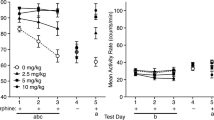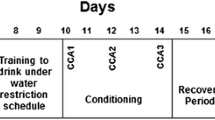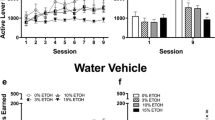Abstract
Human subjects were given a series of oral ethanol administrations in one environment and an equal number of placebo administrations in another distinct environment. Tolerance (a decreasing response with repeated administrations) to the tachycardia effect of ethanol was observed; no consistent changes in heart rate followed placebo administrations. Subsequently, tolerance to a test dose of ethanol administered in the environment normally associated with placebo was reduced relative to that in response to a dose administered in the usual ethanol environment. This demonstration of environment-specificity in a human drug tolerance experiment replicates previous reports from animal studies, and is interpreted according to a Pavlovian conditioning model of drug tolerance.
Similar content being viewed by others
References
Advokat C (1980) Evidence for conditioned tolerance of the tail-flick reflex. Behav Neur Biol 29:385–389
Crowill CR, Hinson RE, Siegel S (1981) The role of conditional drug responses in tolerance to the hypothermic effects of ethanol. Psychopharmacology 73:51–54
Doctor RF, Naitoh P, Smith JC (1966) Electroencephalographic changes and vigilance behaviour during experimentally-induced intoxication with alcoholic subjects. Psychosom Med 28:605–615
Hayes RL, Mayer DJ (1978) Morphine tolerance: Is there evidence for a conditioning model? Science 200:343–344
Holmberg G, Martens S (1958) Electroencephalographic changes in man correlated with blood alcohol concentration and some other conditions following standardized ingestion of alcohol. Q J Stud Alc 16:411–424
Lê AD, Poulos CX, Cappell H (1979) Conditioned tolerance to the hypothermic effect of ethyl alcohol. Science 206:1109–1110
Lubow RE (1973) Latent inhibition. Psychol Bull 79:398–407
Mansfield JG, Cunningham C (1980) Conditioned tolerance to the hypothermic effect of ethyl alcohol. J Comp Physiol Psychol 94:962–969
Paviov IP (1927) Conditioned reflexes (GV Anrep trans). Oxford University Press, London, p 35
Siegel S (1976) Morphine analgesic tolerance: Its situation specificity supports a Pavlovian conditioning model. Science 193:323–325
Siegel S (1977) Morphine tolerance acquisition as an associative process. J Exp Psychol: Animal Behavior Processes 3:1–13
Siegel S (1978) Tolerance to the hyperthermic effect of morphine in the rat is a learned response. J Comp Physiol Psychol 92:1137–1149
Siegel S (1979) The role of conditioning in drug tolerance and addiction. In: Keehn JD (ed) Psychopathology in animals: Research and treatment implications. Academic Press, New York, pp 143–168
Siegel S, Hinson RE, Krank MD (1979) Modulation of tolerance to the lethal effect of morphine by extinction. Behav Neur Biol 25:257–262
Stockwell T, Hodgson R, Edwards G, Taylor C, Rankin H (1979) The development of a questionnaire to measure the severity of alcohol dependence. Br J Addict 74 (1):79
Author information
Authors and Affiliations
Rights and permissions
About this article
Cite this article
Dafters, R., Anderson, G. Conditioned tolerance to the tachycardia effect of ethanol in humans. Psychopharmacology 78, 365–367 (1982). https://doi.org/10.1007/BF00433743
Received:
Issue Date:
DOI: https://doi.org/10.1007/BF00433743




